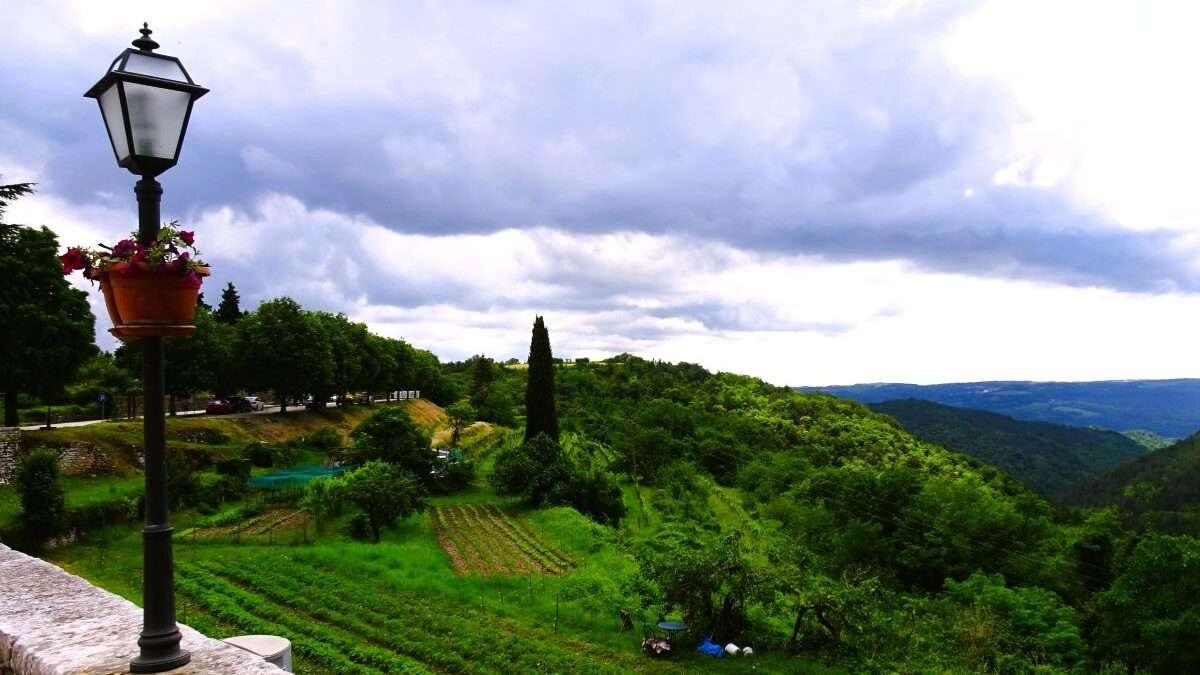Elvis was the tour guide on our first Istrian excursion; we waved goodbye to our holiday resort for the day. Could it be his real name? It was unusual for a young Croat, but Mr Word Loft and I decided it was genuine after hearing his account of comical interactions about it throughout his life.
He was very informative and talked a lot, which is a compliment as he was fuelled with fascinating facts about the part of Istria we were touring. Not surprisingly, as we found out later, he is a professor of history.
The first stop was Groznjan, popular with artists who gather there, past and present. The coach pulled up near a church with rows of cypress trees, specifically chosen because of their links to a Greek mythological tale.
Apollo, the Greek god, presented a stag to his lover Cyparrius who accidentally speared it to death while hunting in the woods. He died of grief, metamorphosed into a cypress tree, and the stag’s spirit ascended to the heavens via its pointing foliage. Some believe this is why they are planted by graveyards enabling deceased souls to do the same.
It’s a fantastical story, and as you have probably guessed from past posts, I’m a great fan of legends and Greek mythology.
A side road leads to the main town. At the top, it opens up onto a small marketplace selling antiques and art. Prices weren’t marked up, and it wasn’t easy to converse, so we didn’t buy anything.
Along the boundary walls, metal ship sculptures sail towards a horizon of green, where the countryside is a mixture of hues; emerald, peridot and mint. Refreshing to behold and revitalised by heavy rainfall come wintertime.
It hardly rains in the summer, but the distant rumbling of thunder and lightning flashes loomed and was atmospheric.
In the shade of a spreading tree, we were told about a building called a castle. Although it was mentioned in 1102, it doesn’t look like a castle. However, it was the seat of feudal lords, and Venetian captains lived there. Vestiges of the original structure can be seen from the southern side, but the main architecture is from the 19th century. Today it is a cultural and musical centre for students.
There are many artisan shops in the well-preserved Medieval centre, although Baroque decoration is evident on some façades too.
We were invited into a retail outlet to try local truffles and liqueurs. All were delicious, although I don’t care very much for the aftertaste of truffles, even though they are a delicacy.
Close by, scarlet geraniums sit at the base of columns and complement the loggia’s pale-cream-plastered walls. Known as the Fonticus, it was a courtroom and prison from the late 1590s. Just imagine all the comings and goings it must have seen back then.
In cobbled winding lanes, there is a friendly atmosphere. We wandered through archways, by idyllic houses and sipped homemade cloudy lemonade from a bar’s terrace overlooking rolling hills. Then it was onto another location.
Oprtalj. There the Venetian loggia is grander than the Fonticus. It takes in panoramic views over the Osoje Valley. Painted in rich terracotta, it’s in accord with other colourful residences. The balustraded entrance faces the remains of homes used by rural folk in the past. They lived on the first floor, and animals sheltered at ground level. The kitchen was always at the top, so if a fire broke out, it didn’t damage all of the property or harm inhabitants. Maybe it’s an idea that should be adopted in today’s home designs. Nowadays, deserted dwellings are creatively adorned with unusual installations, such as hats suspended above alleyways. Certain doors are painted in unusual themes; my favourite depicted hanging Santa plaques with uplifting words.
It’s a small town, but there are two churches. They were locked, but I heard both have frescoes worth seeing. And as we strolled around the gardens of the larger, graphite clouds gathered threateningly, so we were thankful to board the coach.
So on to our final destination, Cepic. A little village where we drove to a farm with lines of trees and vines. An independent business growing produce – grapes for wine and brandy and olives for oil.
Our group received a warm welcome and was offered three of the Coslovich wines, along with local nibbles. Spicy cold meats and sausages, smoked and cured in the fresh air, and cheese. Fig and apricot jams. We dipped smidgeons of bread into flavoured olive oil. It’s used as a condiment in Croatia, as it’s thought to be too precious for cooking, and I have to agree.
The visit was a great way to learn about the local wines so we knew what we were ordering over the following two weeks.
I’ll let you know how our Croatian holiday continued in my next blog post.
Until then,
Sue. X

